SHC Students Protest Sexual Assault Alongside San Francisco High Schools
Students flood the plaza to protest sexual assault and demonstrate solidarity with victims.
Over the past couple of weeks, high school students across San Francisco have been walking out of their classes to raise awareness about the prevalence of sexual assault and to protest administrations’ handling of sexual assault allegations. Public schools, such as Lowell, Ruth Asawa SOTA, George Washington, and Abraham Lincoln, have organized large-scale walkouts over the past month as part of a larger movement to hold sexual perpetrators accountable and help heal survivors. In solidarity, SHC students walked out of their block 1 classes on November 12th and sat in silence for 10 minutes on the plaza.
The sit-in was planned by several members of SHC’s student council and announced via social media the day before. Students reposted a virtual flyer instructing students to wear black or red and to head to the plaza at the end of their block 1 classes.
Thursday evening, only a couple of hours after the flyers began circulating on social media, SHC’s administration sent out an email affirming their support for victims of sexual assault and saying that they support students choosing to participate in the sit-in. In addition, in an email from Dr. Cannon, the SHC administration said that they were looking forward to continuing these conversations in the coming weeks “to create a more just school community and a more just world.”
The Emerald talked to some of the students who attended the sit-in. Here’s what they had to say:
“It’s a really empowering experience to participate in this silent sit-in. It is really important that these stories are heard.” -Conor Hansbury, ‘24
“It’s very important, I’m glad the students are choosing to take a stand to bring attention to the administration.” -Mr. Carey
“I thought it was a very powerful moment sitting in solidarity with so much of the student body.” -Kate Cassidy, ‘24
“I think it was powerful that so many people sat through it to support victims and came together to support this issue, and continue a conversation about it. This kind of stuff is generally thrown to the side and not discussed, so the fact that people are coming together to show that those who face sexual assault are not alone is really impactful.” -Katie Baldwin, ‘23
“I thought Paloma Polacci’s words when she was speaking directly to the faculty were very empowering, she was really strong and composed.” -Alma Larson, ‘24
“I thought the silence of the crowd was so powerful considering that it is very hard to make our whole school completely quiet.” -Imogen Doumani, ‘22
“I’m glad that teachers are finally recognizing what students have gone through and I hope this continues in the future.” -Anonymous, ‘23
“As an alum, I think we should start teaching our kids at this age about this in high school. It’s important to teach students about consent, a culture of sexualization, and sexual assault prevention now so that we can be proactive rather than reactive.” -Ms. Rogers, ‘16
The Emerald also talked to Dean of Students Nicole Nastari about the sit-in to hear admin’s view on the sit-in and its impact:
What is one misconception about the administration and their work that you’d like to dispel?
One of the things that I hear… is that the administration doesn’t care about students. We work so hard to meet and come up with changes to support students and take all of the conversations that we have… into account. So really, it is important that students know that the admin does care deeply about you. It’s why we’re here: because we care about you!
To me, our care and concern was really evident in the response to the sit-in. Dr. Cannon created all these listening sessions because he and the admin really wanted to hear from you and give you a platform to talk with us about these issues.
What do you think was powerful or moving about the demonstration?
I actually got teary… To have that many students sitting in silence for 10 minutes, nobody was on their phone; it was powerful, really powerful! Our students were so truly present and it was powerful and beautiful to me as an educator.
Can you explain the current system for filing claims of sexual assault, and what about the system will change after hearing from students?
What students don’t know that I think is very important is that (with our current reporting system) you can tell any adult on campus. Anyone. Because all of the adults are mandated reporters, and are required to report anything of a sexual nature to a counselor or dean. If information like that comes to the deans, we can then start the investigation process.
Then Mr. Sazo and I begin to have conversations and gather information. We start with questions such as, “What happened?”, “Where?”, “Are there screenshots?”, “Do you have video?” or “Is there anything you can share with me?” After a thorough investigation process… it’s usually the entire administrative team and Dr. Cannon who in the end will make the final decision. Then we focus on the healing with follow-up from counseling with the student and/or victims.
Now, what I’ve been hearing over the past couple of days is that a written reporting system might be helpful. Although you might feel comfortable going in talking to a teacher or a counselor or even my office, you might not. That reporting piece, that form, gives you a little space and distance and a different way of processing that seems like it might be very helpful.
(Ms. Nastari later specified that she and administrators are currently considering what this type of new reporting system could look like, and continuing to discuss this with students as well.)
What would you encourage students who have complaints or concerns about the current system to do?
Have conversations with us! You can stay in the problem or you can be in the solution. My door is always open, it really is! I know people may not feel that way, but anybody that gets me one-on-one knows I’m always willing to listen or talk. You can also talk to a teacher, “Hey, I’m not comfortable talking with Ms. Nastari, but this is really concerning, would you be willing to talk to me about it?”
For example, some teachers held some really great spaces in the classrooms. They took notes and turned them over to us! Sometimes, the container of the classroom is a great space, because kids feel safe, they have positive relationships with their teachers.
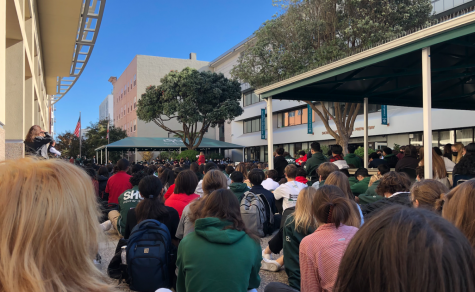
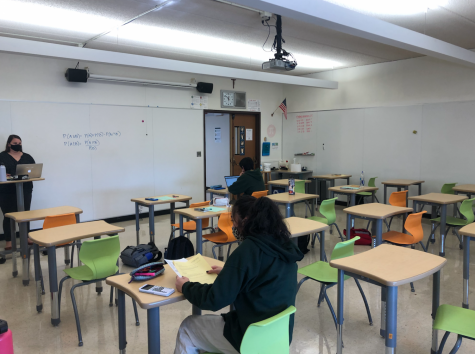
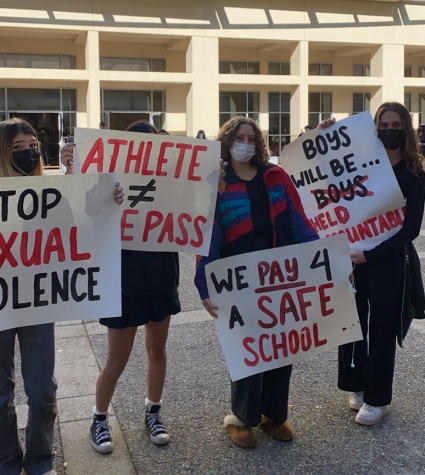
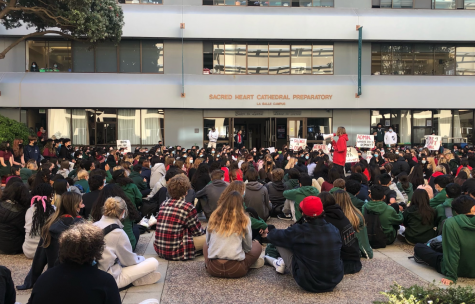
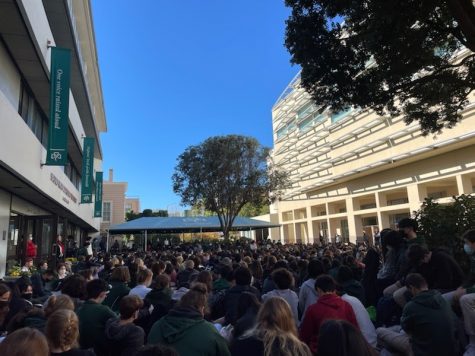
This sit-in was a significant step towards discussing sexual violence at SHC and has sparked conversations among students, faculty, and the administration. Only days after, members of SHC’s student council sat down with Dr. Cannon and the administration to discuss how they can better support students and more effectively address claims of sexual violence. One of the issues that organizers Student Body President Sydney Scott and SBO Spirit Commissioner Paloma Polacci had planned to discuss with the admin was making the process of reporting sexual assault clear to students. Sydney asserts that “it’s really important to know where to go and who to talk to” about sexual violence, both to make claims and receive support. The impacts of the sit-in and these conversations became very clear in the week following the demonstration. Dr. Cannon, along with other admin, hosted four sessions to discuss sexual assault at SHC and to hear directly from students about what could be improved.
One of the major issues brought up in these conversations was the reporting system at SHC. The existing reporting pipeline is outlined in the student handbook and urges students to report sexual harassment or assault to any trusted teacher or administrator (see student handbook section 3E for details). Ms. O’Neill, SHC’s Assistant Principal of Academics, encourages students to work with the Deans and the administration to help strengthen the existing pipeline and to help identify areas that could be improved. Paloma says that she hopes the effect of this sit-in will be a “continuation of dialogue between students and faculty” and states that the sit-in “was the most cooperation and respect [she has] seen from the student body” during her time at SHC.
The sit-in illustrates the power of student activism and reminds us that the demonstration was an important step in initiating a larger conversation that has been unfolding and will continue over the coming weeks.

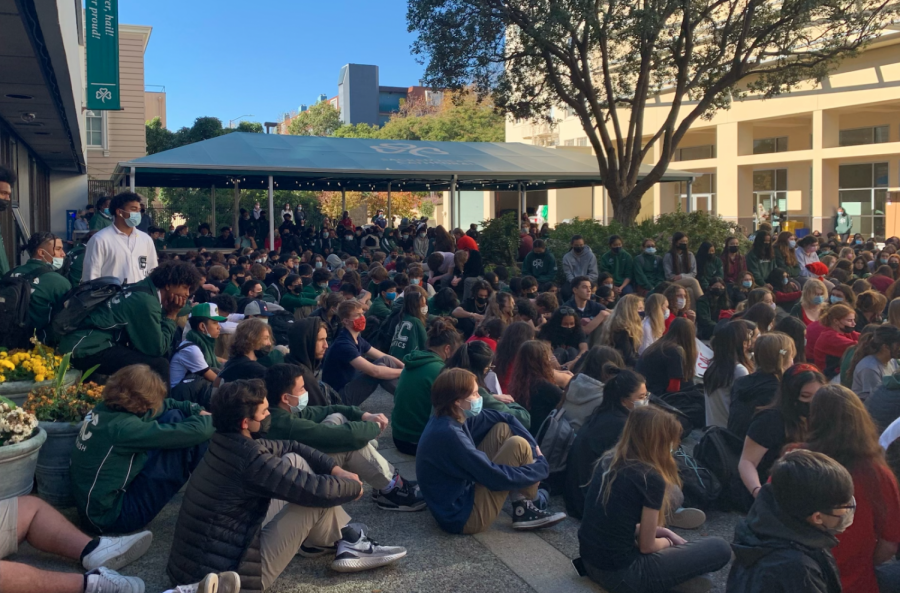





Chardin • Dec 7, 2021 at 6:22 pm
I would say that in order to demonstrate their genuine sincerity and good faith in what they say they’re doing, these students should include in their protest those boys and girls that access pornography on their phones and in so doing enable, endorse and participate in sexual violence.
T. • Nov 30, 2021 at 7:57 pm
Just FYI, men are victims of sexual assault every 45 seconds on average. One huge mistake people make as is posted in “Seniors Morgan Kynoch, Adelaide Brown, and Jackie Jeremi hold up signs protesting sexual violence at SHC” photo is that it extends the dangerous notion that sexual assault is a “men vs. women” issue instead of a correct “assailant vs. crime victim” issue. Women certainly do commit sexual assault. Numbers don’t matter. One time is too many.